Performance Assessment of IMERG V07 Versus V06 for Precipitation Estimation in the Parnaíba River Basin
Highlights
- IMERG V07 reduced systematic errors compared to V06, with lower bias and random errors across most of the basin, while high Rbias values (>70%) persisted in the northeastern highlands due to orographic–convective interactions. Detection capacity also improved, with false alarms reduced by ~5% and KGE increasing by ~11%.
- Cluster-based analysis revealed that V07 better represented seasonal precipitation variability, correcting overestimation in wet periods and underestimation in semi-arid regions.
- These improvements enhance the reliability of IMERG V07 for hydrological and climate applications in tropical basins with strong seasonal variability.
- Persistent errors in mountainous and transitional areas highlight the need for regionalized bias corrections tailored to local climatic and topographic conditions.
Abstract
1. Introduction
2. Materials and Methods
2.1. Study Area
2.2. Data Sources
- a.
- Conventional Rain Gauge Data
- b.
- Gridded Interpolated Data (BR-DWGD)
- c.
- Satellite Precipitation Products (SPPs)
2.3. Methods
2.3.1. Evaluation Framework
- Step 1—Point-scale evaluation: The first stage validated BR-DWGD interpolated precipitation data against daily observations from 58 rain gauges distributed across the Parnaíba River Basin (PRB), verifying its reliability as a reference product for subsequent satellite evaluation.
- Step 2—Gridded-scale evaluation: After confirming the consistency of BR-DWGD data with ground observations, IMERG products were compared against BR-DWGD estimates over a regular 0.1° × 0.1° grid (2765 points), enabling a spatially continuous assessment of IMERG performance across the entire basin domain.
- Temporal dimension:
- Regional (cluster-based) analysis:
2.3.2. Cluster Analysis
- dij = Euclidean distance between points i and j,
- tij = Cophenetic distance between points i and j,
- e = Mean Euclidean and cophenetic distances, respect.
2.3.3. Evaluation Metrics
3. Results
3.1. Assessment of Reference Data
3.2. Evaluation of IMERG V07 Versus V06
3.3. Comparative Analysis by Cluster
3.4. Inter-Cluster Comparison
4. Discussion
5. Conclusions
Author Contributions
Funding
Data Availability Statement
Acknowledgments
Conflicts of Interest
References
- Lee, H.; Calvin, K.; Dasgupta, D.; Krinner, G.; Mukherji, A.; Thorne, P.; Trisos, C.; Romero, J.; Aldunce, P.; Barret, K.; et al. IPCC, 2023: Climate Change 2023: Synthesis Report, Summary for Policymakers. Contribution of Working Groups I, II and III to the Sixth Assessment Report of the Intergovernmental Panel on Climate Change; Core Writing Team, Lee, H., Romero, J., Eds.; IPCC: Geneva, Switzerland, 2023. [CrossRef]
- Rudorff, C.; Sparrow, S.; Guedes, M.R.; Tett, S.F.; Brêda, J.P.L.; Cunningham, C.; Ribeiro, F.N.; Palharini, R.S.; Lott, F.C. Event attribution of Parnaíba River floods in Northeastern Brazil. Clim. Resil. Sustain. 2022, 1, e16. [Google Scholar] [CrossRef]
- Gadelha, A.N.; Coelho, V.H.R.; Xavier, A.C.; Barbosa, L.R.; Melo, D.C.; Xuan, Y.; Huffman, G.J.; Petersen, W.A.; Almeida, C.D.N. Grid box-level evaluation of IMERG over Brazil at various space and time scales. Atmos. Res. 2019, 218, 231–244. [Google Scholar] [CrossRef]
- Hosseini-Moghari, S.-M.; Tang, Q. Validation of GPM IMERG V05 and V06 Precipitation Products over Iran. J. Hydrometeorol. 2020, 21, 1011–1037. [Google Scholar] [CrossRef]
- Huffman, G.J.; Bolvin, D.T.; Joyce, R.; Kelley, O.A.; Nelkin, E.J.; Portier, A.; Stocker, E.F.; Tan, J.; Watters, D.C.; West, B.J. IMERG V07 Release Notes; Goddard Space Flight Center: Greenbelt, MD, USA, 2023. Available online: https://gpm.nasa.gov/data/news (accessed on 17 June 2025).
- Guo, H.; Tian, Y.; Li, J.; Guo, C.; Meng, X.; Wang, W.; De Maeyer, P. Has IMERG_V07 Improved the Precision of Precipitation Retrieval in Mainland China Compared to IMERG_V06? Remote Sens. 2024, 16, 2671. [Google Scholar] [CrossRef]
- Liu, Z.; Hou, H.; Zhang, L.; Hu, B. Event-Based Bias Correction of the GPM IMERG V06 Product by Random Forest Method over Mainland China. Remote Sens. 2022, 14, 3859. [Google Scholar] [CrossRef]
- Watters, D.C.; Gatlin, P.N.; Bolvin, D.T.; Huffman, G.J.; Joyce, R.; Kirstetter, P.; Nelkin, E.J.; Ringerud, S.; Tan, J.; Wang, J.; et al. Oceanic Validation of IMERG-GMI Version 6 Precipitation Using the GPM Validation Network. J. Hydrometeorol. 2024, 25, 125–142. [Google Scholar] [CrossRef]
- Ramadhan, R.; Marzuki, M.; Suryanto, W.; Sholihun, S.; Yusnaini, H.; Muharsyah, R. Validating IMERG data for diurnal rainfall analysis across the Indonesian maritime continent using gauge observations. Remote Sens. Appl. 2024, 34, 101186. [Google Scholar] [CrossRef]
- Wang, Y.; Li, Z.; Gao, L.; Zhong, Y.; Peng, X. Comparison of GPM IMERG Version 06 Final Run Products and Its Latest Version 07 Precipitation Products across Scales: Similarities, Differences and Improvements. Remote Sens. 2023, 15, 5622. [Google Scholar] [CrossRef]
- Rozante, J.R.; Rozante, G. IMERG V07B and V06B: A Comparative Study of Precipitation Estimates Across South America with a Detailed Evaluation of Brazilian Rainfall Patterns. Remote Sens. 2024, 16, 4722. [Google Scholar] [CrossRef]
- Shimizu, M.H.; Anochi, J.A.; Kayano, M.T. Precipitation patterns over northern Brazil basins: Climatology, trends, and associated mechanisms. Theor. Appl. Climatol. 2022, 147, 767–783. [Google Scholar] [CrossRef]
- ANA. Conjuntura dos Recursos Hídricos: Informe 2016; Agência Nacional de Águas—Brasília (ANA): Brasília, Brazil, 2016.
- Souza, C.D.d.e.; Matos, A.J.S. Operação do Sistema de Alerta Hidrológico da Bacia do Rio Parnaiba—2022; Serviço Geológico do Brasil—CPRM: Teresina, Brazil, 2022. Available online: https://www.cprm.gov.br/sace/parnaiba (accessed on 8 September 2025).
- Alvares, C.A.; Stape, J.L.; Sentelhas, P.C.; Gonçalves, J.D.M.; Sparovek, G. Köppen’s climate classification map for Brazil. Meteorol. Z. 2013, 22, 711–728. [Google Scholar] [CrossRef]
- Reis, L.C.D.; Silva, C.M.S.E.; Bezerra, B.G.; Spyrides, M.H.C. Caracterização da variabilidade da precipitação no MATOPIBA, região produtora de soja (Vol. 13, Número 04). Revista Brasileira de Geografia Física. 2020. Available online: https://periodicos.ufpe.br/revistas/rbgfe (accessed on 1 September 2025).
- de Abreu, L.P.; Mutti, P.R.; Lima, K.C. Variabilidade espacial e temporal da precipitação na bacia hidrográfica do Rio Parnaíba, Nordeste do Brasil. Rev. Bras. De Meio Ambiente 2019, 7, 082–097. [Google Scholar] [CrossRef]
- Motta, E.D.O.; Gonçalves, N.E.W. Plano Nascente Parnaíba: Plano de Preservação e Recuperação de Nascentes da Bacia do Rio Parnaíba; Companhia de Desenvolvimento dos Vales do São Francisco e do Parnaíba (Codevasf)/Editora IABS: Brasília, Brazil, 2016; Available online: http://jbb.ibict.br//handle/1/689 (accessed on 8 September 2025).
- Macedo, M.J.H.; Santos, F.A.C.; de Sousa, F.D.A.S. Geoprocessamento aplicado as características físicas e biofísicas da Bacia Hidrográfica do Rio Parnaíba. Revista de Geografia 2017, 34. [Google Scholar] [CrossRef]
- Nascimento, J.R.S.D.; Marcuzzo, F.F.N.; Pinto, E.J.A. Mapas Da Distribuição Anual e Mensal De Chuva e Pluviograma Da Bacia Hidrográfica do Rio Parnaíba. 2020. Available online: http://rigeo.cprm.gov.br/jspui/handle/doc/18492 (accessed on 21 May 2025).
- Xavier, A.C.; Scanlon, B.R.; King, C.W.; Alves, A.I. New improved Brazilian daily weather gridded data (1961–2020). Int. J. Climatol. 2022, 42, 8390–8404. [Google Scholar] [CrossRef]
- Xavier, A.C.; King, C.W.; Scanlon, B.R. Daily gridded meteorological variables in Brazil (1980–2013). Int. J. Climatol. 2016, 36, 2644–2659. [Google Scholar] [CrossRef]
- Huffman, G.J.; Bolvin, D.T.; Braithwaite, D.; Hsu, K.L.; Joyce, R.J.; Kidd, C.; Nelkin, E.J.; Sorooshian, S.; Stocker, E.F.; Tan, J.; et al. Integrated Multi-satellite Retrievals for the Global Precipitation Measurement (GPM) Mission (IMERG). In Satellite Precipitation Measurement; Springer International Publishing: Cham, Switzerland, 2020; pp. 343–353. [Google Scholar] [CrossRef]
- Campos, J.A.; da Silva, D.D.; Pires, G.F.; Amorim, R.S.S.; de Menezes Filho, F.C.M.; de Melo Ribeiro, C.B.; Lorentz, J.F.; Aires, U.R.V. Modeling Environmental Vulnerability for 2050 Considering Different Scenarios in the Doce River Basin, Brazil. Water 2024, 16, 1459. [Google Scholar] [CrossRef]
- de Andrade, J.M.; Neto, A.R.; Bezerra, U.A.; Moraes, A.C.C.; Montenegro, S.M.G.L. A comprehensive assessment of precipitation products: Temporal and spatial analyses over terrestrial biomes in Northeastern Brazil. Remote Sens. Appl. 2022, 28, 100842. [Google Scholar] [CrossRef]
- Bender, F.D.; Sentelhas, P.C. Solar Radiation Models and Gridded Databases to Fill Gaps in Weather Series and to Project Climate Change in Brazil. Adv. Meteorol. 2018, 2018, 6204382. [Google Scholar] [CrossRef]
- Melo, D.D.C.; Xavier, A.C.; Bianchi, T.; Oliveira, P.T.; Scanlon, B.R.; Lucas, M.C.; Wendland, E. Performance evaluation of rainfall estimates by TRMM Multi—Satellite Precipitation Analysis 3B42V6 and V7 over Brazil. J. Geophys. Res. Atmos. 2015, 120, 9426–9436. [Google Scholar] [CrossRef]
- Ward, J.H. Hierarchical Grouping to Optimize an Objective Function. J. Am. Stat. Assoc. 1963, 58, 236–244. [Google Scholar] [CrossRef]
- Rodrigues, D.T.; Gonçalves, W.A.; Spyrides, M.H.C.; Silva, C.M.S.E. Spatial and temporal assessment of the extreme and daily precipitation of the Tropical Rainfall Measuring Mission satellite in Northeast Brazil. Int. J. Remote Sens. 2020, 41, 549–572. [Google Scholar] [CrossRef]
- Silva, M.E.S.; da Rocha, R.P.; Pereira, G.; Rocha, A.M.; Mendes, D.; da Silva, C.B. The combined influences of Amazon deforestation and Pacific Decadal Oscillation on the South America climate variability. Int. J. Climatol. 2023, 43, 2127–2149. [Google Scholar] [CrossRef]
- Santos e Silva, C.M.; Rodrigues, D.T.; Medeiros, F.; Valentim, A.M.; de Araújo, P.A.A.; da Silva Pinto, J.; Mutti, P.R.; Mendes, K.R.; Bezerra, B.G.; de Oliveira, C.P.; et al. Diurnal cycle of precipitation in Brazil. Theor. Appl. Climatol. 2024, 155, 7811–7826. [Google Scholar] [CrossRef]
- Everitt, B.S.; Landau, S.; Leese, M.; Stahl, D. Cluster Analysis, 5th ed.; John Wiley & Sons Ltd.: West Sussex, UK, 2011. [Google Scholar] [CrossRef]
- Romesburg, H.C. Cluster Analysis for Researchers; Reprint of 1984 edit; Lulu Press: Morrisville, NC, USA, 2004. [Google Scholar]
- Wilks, D.S. Statistical Methods in the Atmopspheric Sciencies. In International Geophycs Series; Academic press: Cambridge, MA, USA, 2011; p. 649. [Google Scholar]
- Morais, R.C.D.S.; De Abreu, L.P. Análise Espacial Da Variabilidade De Precipitação Na Bacia Hidrográfica Do Rio Parnaíba, Nordeste De Brasil Spatial Analysis of Precipitation Variability in Parnaíba River Watershed, Northeast of Brazil. Rev. Acad. Ciências Piauí 2021, 2, 3–18. [Google Scholar] [CrossRef]
- Zhang, M.; de Leon, C.; Migliaccio, K. Evaluation and comparison of interpolated gauge rainfall data and gridded rainfall data in Florida, USA. Hydrol. Sci. J. 2018, 63, 561–582. [Google Scholar] [CrossRef]
- Zhao, K.; Zhong, S. Evaluation and Error Analysis of Multi-Source Precipitation Datasets during Summer over the Tibetan Plateau. Atmosphere 2024, 15, 165. [Google Scholar] [CrossRef]
- Polasky, A.; Sapkota, V.; Forest, C.E.; Fuentes, J.D. Discrepancies in precipitation trends between observational and reanalysis datasets in the Amazon Basin. Sci. Rep. 2025, 15, 7268. [Google Scholar] [CrossRef]
- Rasera, J.B.; Silva, R.F.D.; Piedade, S.; Mourão Filho, F.D.A.A.; Delbem, A.C.B.; Saraiva, A.M.; Sentelhas, P.C.; Marques, P.A.A. Do Gridded Weather Datasets Provide High-Quality Data for Agroclimatic Research in Citrus Production in Brazil? AgriEngineering 2023, 5, 924–940. [Google Scholar] [CrossRef]
- Batista, F.F.; Rodrigues, D.T.; Santos e Silva, C.M. Analysis of climatic extremes in the Parnaíba River Basin, Northeast Brazil, using GPM IMERG-V6 products. Weather. Clim. Extrem. 2024, 43, 100646. [Google Scholar] [CrossRef]
- dos Santos, A.L.M.; Gonçalves, W.A.; Rodrigues, D.T.; Andrade, L.d.M.B.; e Silva, C.M.S. Evaluation of extreme precipitation indices in Brazil’s semiarid region from satellite data. Atmosphere 2022, 13, 1598. [Google Scholar] [CrossRef]
- Xu, F.; Zhou, Y.; Zhao, L. Spatial and temporal variability in extreme precipitation in the Pearl River Basin, China from 1960 to 2018. Int. J. Climatol. 2022, 42, 797–816. [Google Scholar] [CrossRef]
- Tinôco, I.C.M.; Bezerra, B.G.; Lucio, P.S.; Barbosa, L.M. Characterization of Rainfall Patterns in the Semiarid Brazil. Anuário Inst. Geociências—UFRJ 2018, 41, 397–409. [Google Scholar] [CrossRef]
- Guedes, R.D.S.; Lima, F.D.; Amanajás, J.C.; Braga, C.C. Análise Em Componentes Principais Da Precipitação Pluvial No Estado Do Piauí e Agrupamento Pelo Método De Ward. Rev. Geogr. 2010, 27, 218–233. [Google Scholar]
- Lyu, X.; Li, Z.; Li, X. Evaluation of Gpm Imerg Satellite Precipitation Products in Event-Based Flood Modeling over the Sunshui River Basin in Southwestern China. Remote Sens. 2024, 16, 2333. [Google Scholar] [CrossRef]
- Couto, F.T.; Ducrocq, V.; Salgado, R.; Costa, M.J. Numerical simulations of significant orographic precipitation in Madeira island. Atmos Res. 2016, 169, 102–112. [Google Scholar] [CrossRef]
- Couto, F.T.; Ducrocq, V.; Salgado, R.; Costa, M.J. Understanding significant precipitation in Madeira island using high—Resolution numerical simulations of real cases. Q. J. R. Meteorol. Soc. 2017, 143, 251–264. [Google Scholar] [CrossRef]
- Costa, M.J.; Salgado, R.; Santos, D.; Levizzani, V.; Bortoli, D.; Silva, A.M.; Pinto, P. Modelling of orographic precipitation over Iberia: A springtime case study. Adv. Geosci. 2010, 25, 103–110. [Google Scholar] [CrossRef]




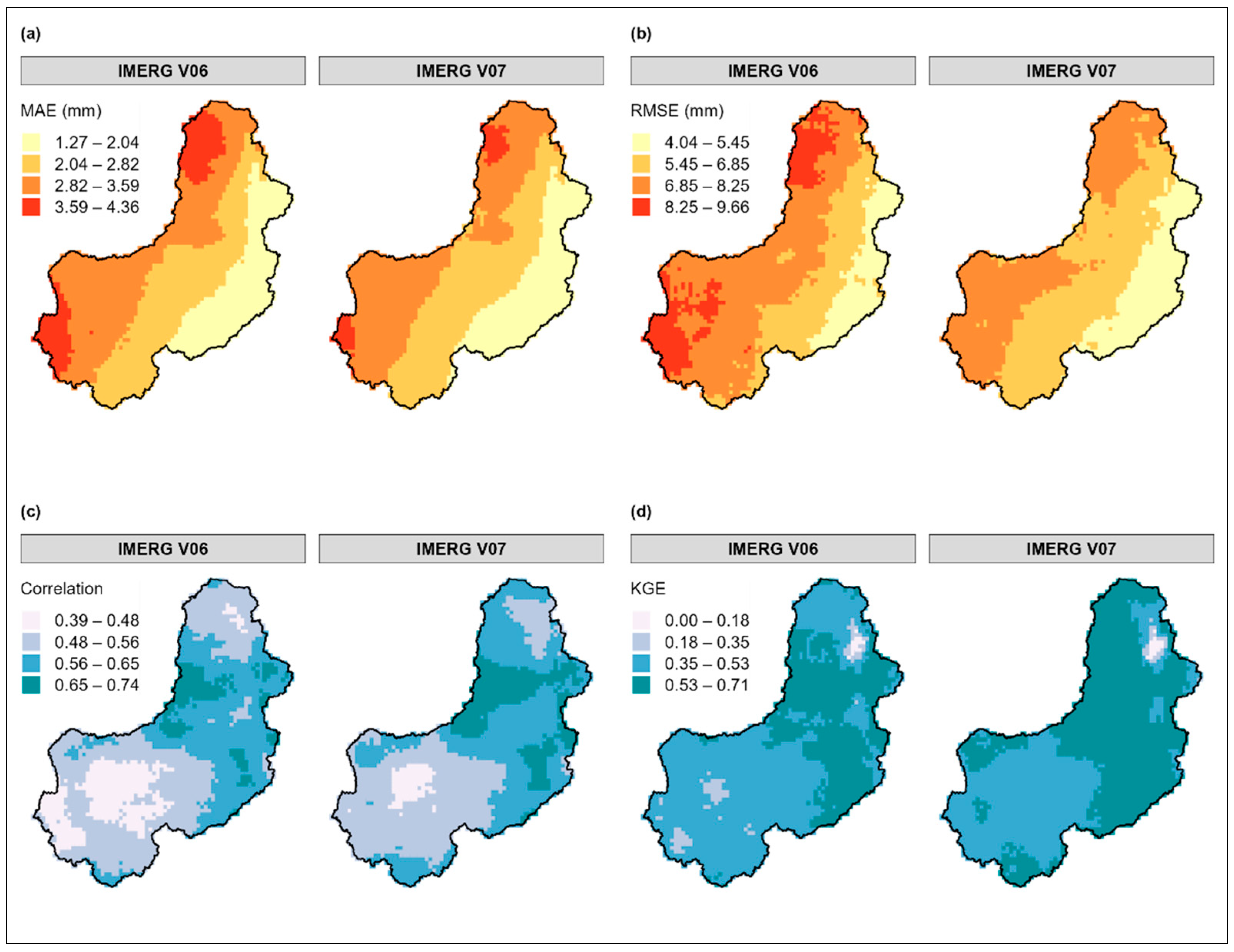

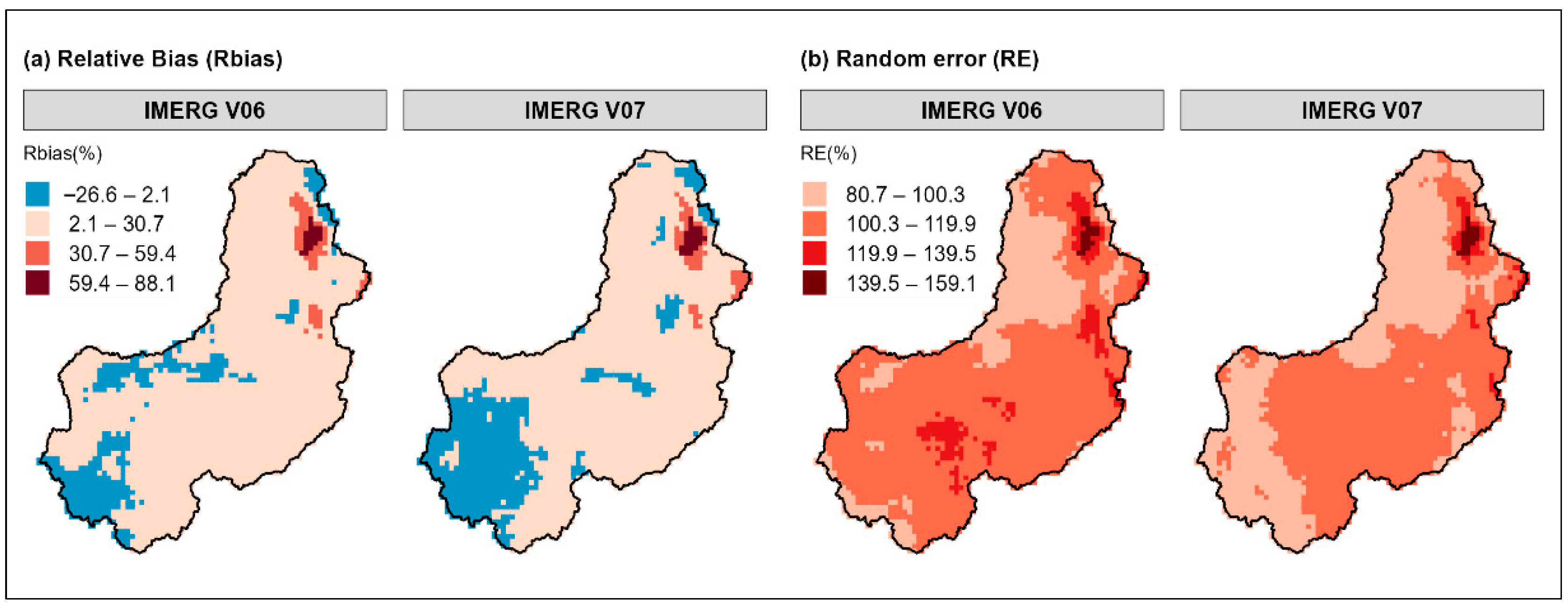
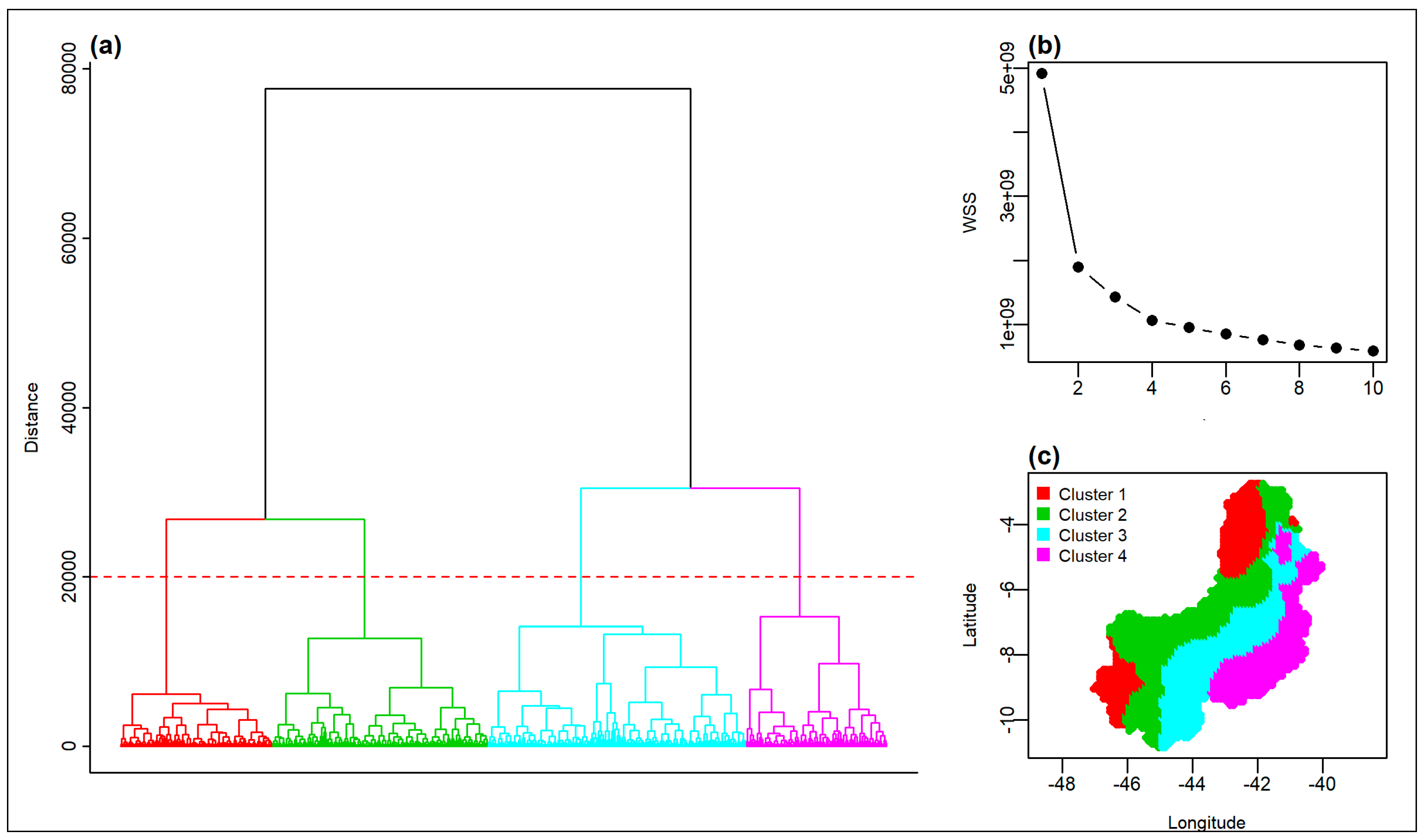
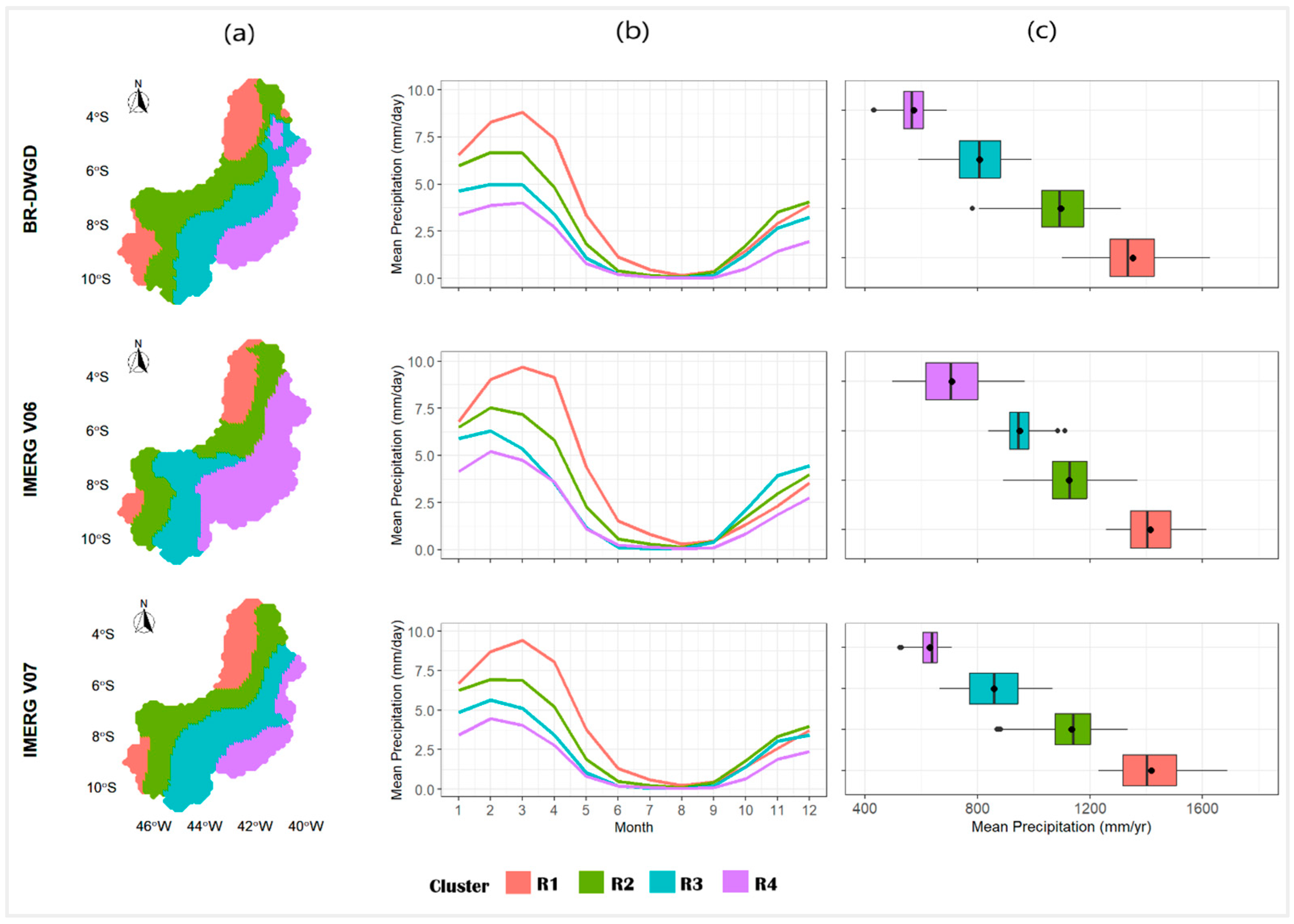
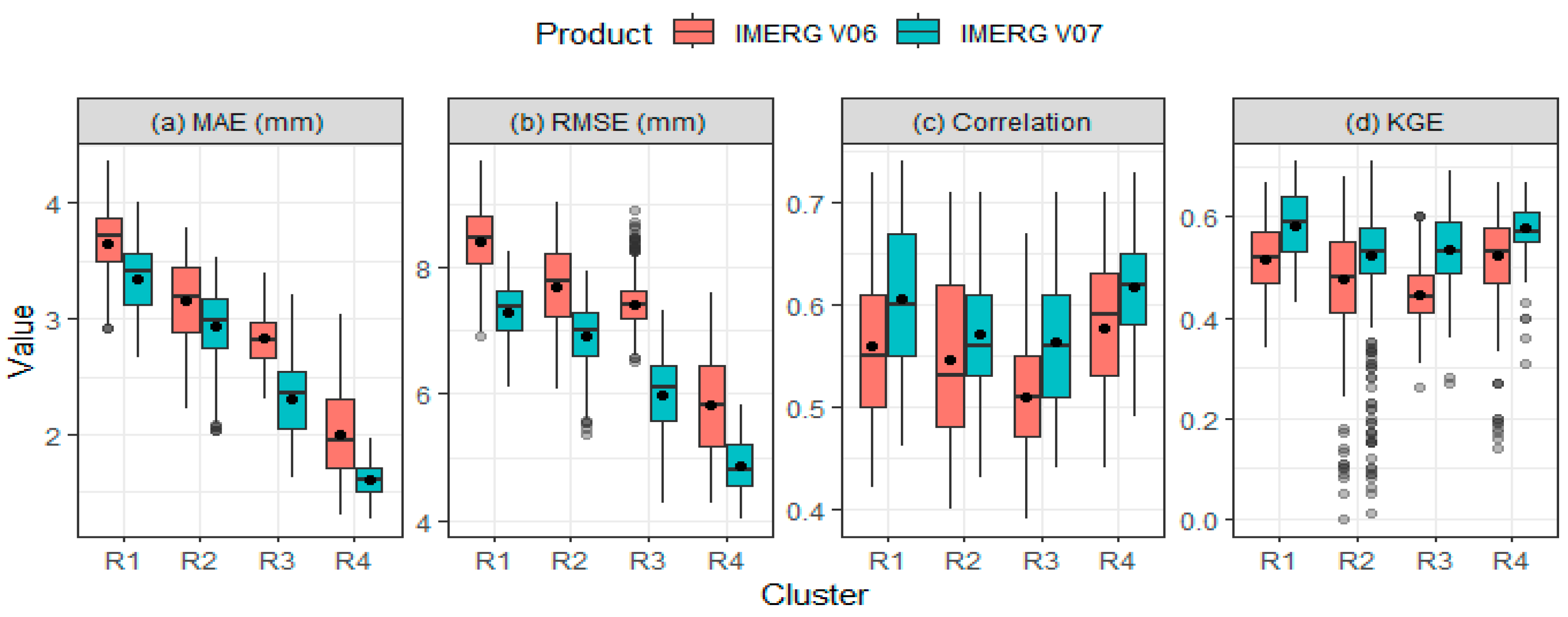
| Metric | Equation | Perfect Value | Unit | |
|---|---|---|---|---|
| Probability of detection (POD) | 1 | — | (3) | |
| False alarm ratio (FAR) | 0 | — | (4) | |
| Correlation coefficient (CC) | 1 | — | (5) | |
| Root-mean-square error (RMSE) | 0 | mm | (6) | |
| Relative bias | 0 | % | (7) | |
| Random Error | 0 | % | (8) | |
| Kling-Gupta Efficiency (KGE) | 1 | — | (9) |
| Observed Precipitation (Mean, sd) (mm/Day) | Estimated (BR-DWGD) (Mean, sd) (mm/Day) | Bias (mm/Day) | Relative Bias (%) | RMSE (mm/Day) | Correlation | |
|---|---|---|---|---|---|---|
| Annual | 2.83 (6.85) | 2.86 (9.40) | 0.03 | 1.17 | 5.53 | 0.81 |
| DJF | 5.01 (8.82) | 5.09 (12.36) | 0.07 | 1.44 | 7.46 | 0.80 |
| MAM | 4.66 (8.04) | 4.70 (11.31) | 0.03 | 0.73 | 6.84 | 0.79 |
| JJA | 0.30 (1.41) | 0.30 (1.98) | 0.00 | 1.34 | 1.29 | 0.75 |
| SON | 1.35 (4.36) | 1.36 (6.27) | 0.02 | 1.69 | 3.79 | 0.79 |
| Metric | IMERG (Version) | DJF | MAM | JJA | SON | Annual |
|---|---|---|---|---|---|---|
| RBias (%) | V07 | 7.76 | 5.36 | 14.3 | 11.4 | 7.4 |
| V06 | 10.6 | 7.4 | 28.9 | 11.9 | 9.85 | |
| RE (%) | V07 | 98.2 | 95.9 | 140.0 | 118.0 | 100.64 |
| V06 | 104.0 | 100.0 | 152.0 | 122.0 | 105.58 | |
| RMSE | V07 | 8.83 | 7.81 | 1.56 | 4.96 | 6.43 |
| V06 | 9.83 | 8.7 | 1.73 | 5.41 | 7.14 | |
| KGE | V07 | 0.532 | 0.557 | 0.476 | 0.500 | 0.572 |
| V06 | 0.475 | 0.492 | 0.406 | 0.456 | 0.516 | |
| CORR | V07 | 0.545 | 0.574 | 0.498 | 0.515 | 0.586 |
| V06 | 0.515 | 0.538 | 0.483 | 0.485 | 0.553 | |
| BETA | V07 | 1.077 | 1.053 | 1.143 | 1.113 | 1.073 |
| V06 | 1.105 | 1.073 | 1.288 | 1.118 | 1.098 | |
| GAMMA | V07 | 1.079 | 1.108 | 1.045 | 1.044 | 1.077 |
| V06 | 1.170 | 1.196 | 1.046 | 1.130 | 1.158 | |
| POD (%) | V07 | 0.697 | 0.665 | 0.385 | 0.583 | 0.732 |
| V06 | 0.681 | 0.662 | 0.392 | 0.561 | 0.753 | |
| FAR (%) | V07 | 0.276 | 0.252 | 0.633 | 0.428 | 0.277 |
| V06 | 0.267 | 0.253 | 0.645 | 0.425 | 0.293 |
| Cluster Region | DJF | MAM | JJA | SON | |
|---|---|---|---|---|---|
| R1 | BR-DWGD | 6.16 (9.23) | 6.51 (9.37) | 0.58 (2.39) | 1.58 (4.86) |
| IMERG V06 | 6.43 (11.54) | 7.73 (13.18) | 0.87 (3.68) | 1.35 (5.35) | |
| IMERG V07 | 6.3 (10.54) | 7.07 (11.25) | 0.69 (3.09) | 1.48 (5.11) | |
| R2 | BR-DWGD | 5.54 (8.93) | 4.43 (7.91) | 0.21 (1.39) | 1.87 (5.60) |
| IMERG V06 | 5.99 (11.73) | 5.08 (10.47) | 0.34 (2.03) | 1.69 (6.23) | |
| IMERG V07 | 5.69 (10.41) | 4.66 (9.24) | 0.27 (1.73) | 1.85 (6.08) | |
| R3 | BR-DWGD | 3.14 (6.69) | 4.27 (8.02) | 0.11 (0.97) | 1.36 (4.75) |
| IMERG V06 | 3.35 (8.66) | 5.55 (11.38) | 0.08 (0.89) | 2.12 (7.28) | |
| IMERG V07 | 3.19 (7.70) | 4.61 (9.23) | 0.10 (0.95) | 1.54 (5.43) | |
| R4 | BR-DWGD | 3.05 (7.26) | 2.50 (6.06) | 0.10 (0.90) | 0.66 (3.30) |
| IMERG V06 | 4.02 (9.57) | 3.16 (8.23) | 0.14 (1.18) | 0.93 (4.37) | |
| IMERG V07 | 3.38 (8.14) | 2.55 (6.93) | 0.11 (1.02) | 0.87 (4.18) |
| Cluster | Mean KGE (sd) (IMERG V06) | Mean KGE (sd) (IMERG V07) | W Statistic | p-Value |
|---|---|---|---|---|
| R1 | 0.485 (0.079) | 0.558 (0.065) | 63,952.5 | <0.001 |
| R2 | 0.485 (0.085) | 0.544 (0.076) | 264,005.0 | <0.001 |
| R3 | 0.484 (0.078) | 0.537 (0.066) | 178,577.0 | <0.001 |
| R4 | 0.522 (0.098) | 0.550 (0.106) | 108,399.5 | <0.001 |
Disclaimer/Publisher’s Note: The statements, opinions and data contained in all publications are solely those of the individual author(s) and contributor(s) and not of MDPI and/or the editor(s). MDPI and/or the editor(s) disclaim responsibility for any injury to people or property resulting from any ideas, methods, instructions or products referred to in the content. |
© 2025 by the authors. Licensee MDPI, Basel, Switzerland. This article is an open access article distributed under the terms and conditions of the Creative Commons Attribution (CC BY) license (https://creativecommons.org/licenses/by/4.0/).
Share and Cite
Batista, F.F.; Rodrigues, D.T.; Santos e Silva, C.M.; Andrade, L.d.M.B.; Mutti, P.R.; Potes, M.; Costa, M.J. Performance Assessment of IMERG V07 Versus V06 for Precipitation Estimation in the Parnaíba River Basin. Remote Sens. 2025, 17, 3613. https://doi.org/10.3390/rs17213613
Batista FF, Rodrigues DT, Santos e Silva CM, Andrade LdMB, Mutti PR, Potes M, Costa MJ. Performance Assessment of IMERG V07 Versus V06 for Precipitation Estimation in the Parnaíba River Basin. Remote Sensing. 2025; 17(21):3613. https://doi.org/10.3390/rs17213613
Chicago/Turabian StyleBatista, Flávia Ferreira, Daniele Tôrres Rodrigues, Cláudio Moises Santos e Silva, Lara de Melo Barbosa Andrade, Pedro Rodrigues Mutti, Miguel Potes, and Maria João Costa. 2025. "Performance Assessment of IMERG V07 Versus V06 for Precipitation Estimation in the Parnaíba River Basin" Remote Sensing 17, no. 21: 3613. https://doi.org/10.3390/rs17213613
APA StyleBatista, F. F., Rodrigues, D. T., Santos e Silva, C. M., Andrade, L. d. M. B., Mutti, P. R., Potes, M., & Costa, M. J. (2025). Performance Assessment of IMERG V07 Versus V06 for Precipitation Estimation in the Parnaíba River Basin. Remote Sensing, 17(21), 3613. https://doi.org/10.3390/rs17213613









